ACCT 2013 Cost Accounting: BlindsforShine Ltd Variance Analysis
VerifiedAdded on 2023/06/03
|9
|2051
|277
Case Study
AI Summary
This case study analyzes the budget and variances for BlindsforShine Ltd, a luxury blinds manufacturer, focusing on November 2018 performance. The analysis identifies variances exceeding 5%, explores potential causes such as market downturns and increased material/labor costs, and recommends corrective measures. Recommendations include innovative product changes, effective advertising, bulk purchasing of raw materials, and employee retention strategies. The report emphasizes the importance of accurate budgeting and monitoring to control expenses and achieve financial targets, ultimately aiming to improve the company's profitability and overall performance. The document provides students with a comprehensive case study solution, and Desklib offers a platform for accessing similar resources and study tools.
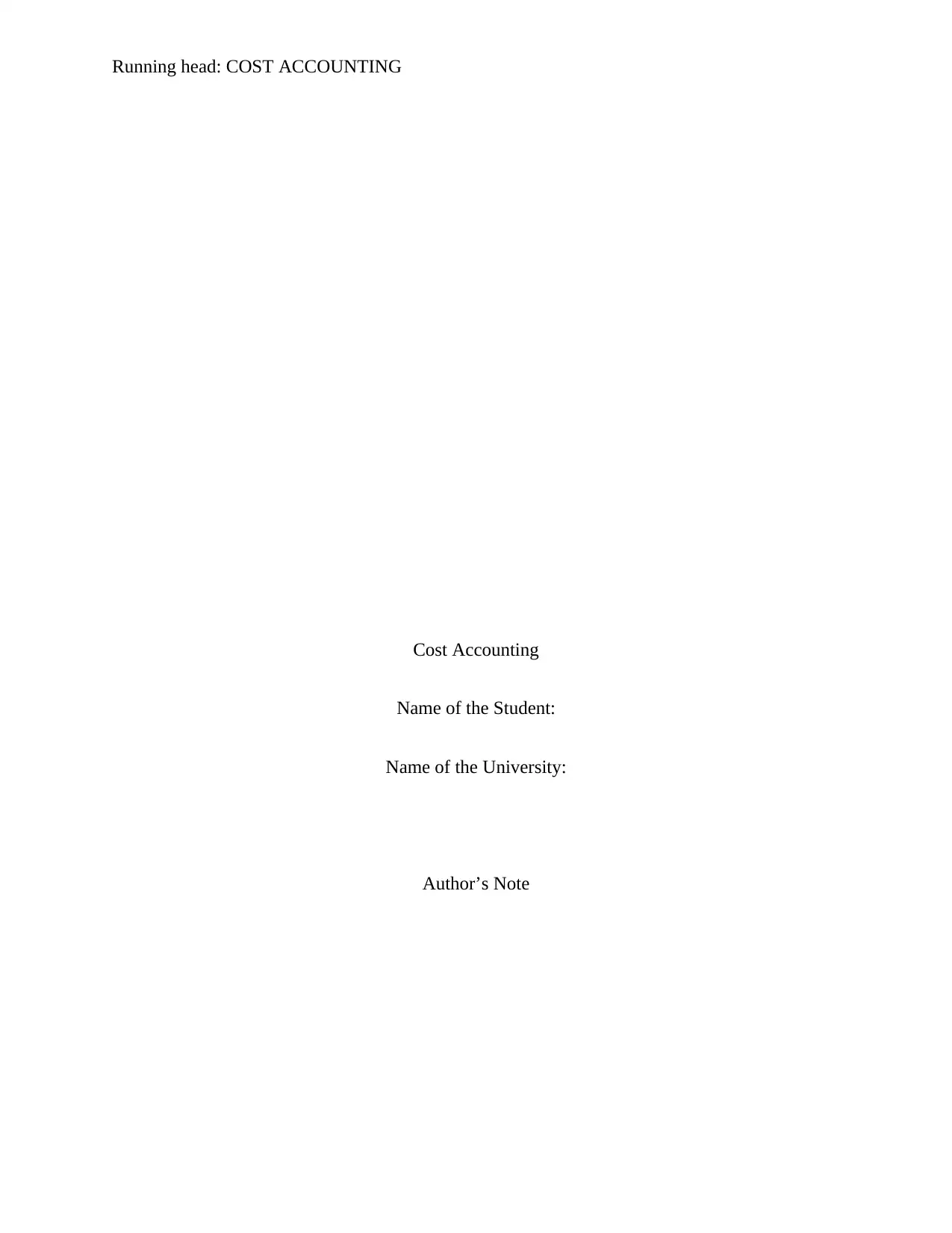
Running head: COST ACCOUNTING
Cost Accounting
Name of the Student:
Name of the University:
Author’s Note
Cost Accounting
Name of the Student:
Name of the University:
Author’s Note
Paraphrase This Document
Need a fresh take? Get an instant paraphrase of this document with our AI Paraphraser
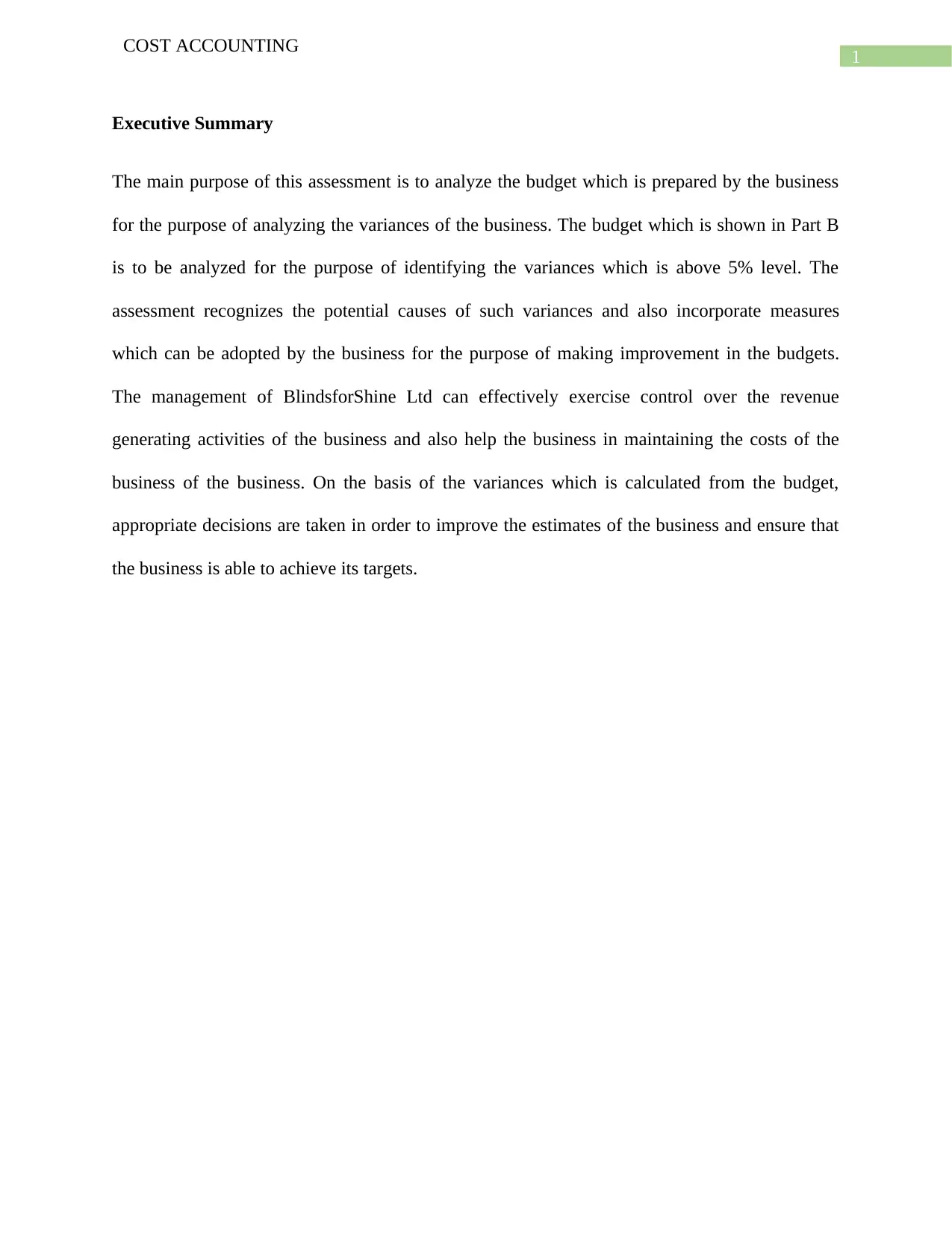
1
COST ACCOUNTING
Executive Summary
The main purpose of this assessment is to analyze the budget which is prepared by the business
for the purpose of analyzing the variances of the business. The budget which is shown in Part B
is to be analyzed for the purpose of identifying the variances which is above 5% level. The
assessment recognizes the potential causes of such variances and also incorporate measures
which can be adopted by the business for the purpose of making improvement in the budgets.
The management of BlindsforShine Ltd can effectively exercise control over the revenue
generating activities of the business and also help the business in maintaining the costs of the
business of the business. On the basis of the variances which is calculated from the budget,
appropriate decisions are taken in order to improve the estimates of the business and ensure that
the business is able to achieve its targets.
COST ACCOUNTING
Executive Summary
The main purpose of this assessment is to analyze the budget which is prepared by the business
for the purpose of analyzing the variances of the business. The budget which is shown in Part B
is to be analyzed for the purpose of identifying the variances which is above 5% level. The
assessment recognizes the potential causes of such variances and also incorporate measures
which can be adopted by the business for the purpose of making improvement in the budgets.
The management of BlindsforShine Ltd can effectively exercise control over the revenue
generating activities of the business and also help the business in maintaining the costs of the
business of the business. On the basis of the variances which is calculated from the budget,
appropriate decisions are taken in order to improve the estimates of the business and ensure that
the business is able to achieve its targets.

2
COST ACCOUNTING
Table of Contents
Part A...............................................................................................................................................3
Budget Report..............................................................................................................................3
Part B...............................................................................................................................................4
Variance Analysis........................................................................................................................4
Recommendation for Variances..................................................................................................5
Reference.........................................................................................................................................8
COST ACCOUNTING
Table of Contents
Part A...............................................................................................................................................3
Budget Report..............................................................................................................................3
Part B...............................................................................................................................................4
Variance Analysis........................................................................................................................4
Recommendation for Variances..................................................................................................5
Reference.........................................................................................................................................8
⊘ This is a preview!⊘
Do you want full access?
Subscribe today to unlock all pages.

Trusted by 1+ million students worldwide
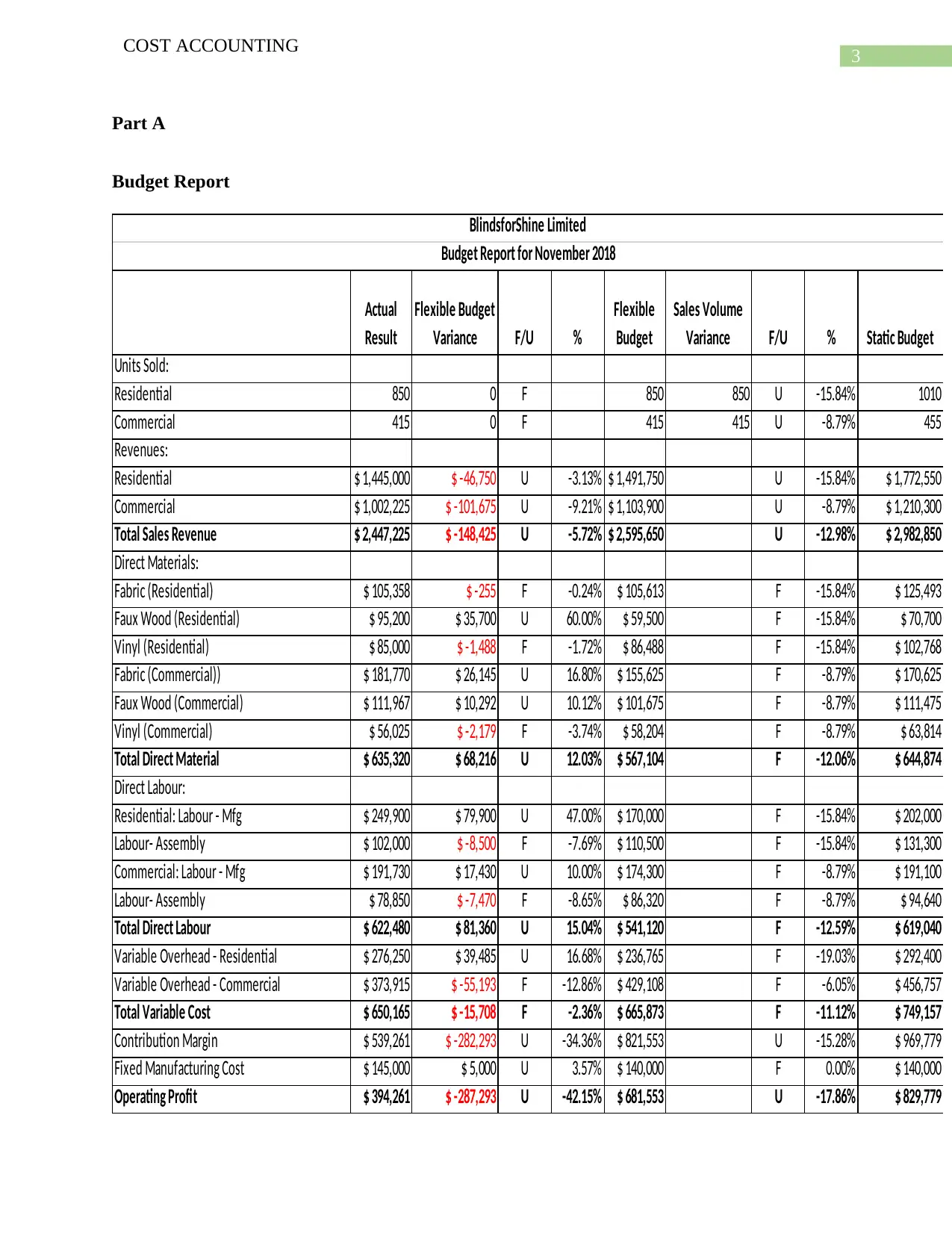
3
COST ACCOUNTING
Part A
Budget Report
Actual
Result
Flexible Budget
Variance F/U %
Flexible
Budget
Sales Volume
Variance F/U % Static Budget
Units Sold:
Residential 850 0 F 850 850 U -15.84% 1010
Commercial 415 0 F 415 415 U -8.79% 455
Revenues:
Residential $ 1,445,000 $ -46,750 U -3.13% $ 1,491,750 U -15.84% $ 1,772,550
Commercial $ 1,002,225 $ -101,675 U -9.21% $ 1,103,900 U -8.79% $ 1,210,300
Total Sales Revenue $ 2,447,225 $ -148,425 U -5.72% $ 2,595,650 U -12.98% $ 2,982,850
Direct Materials:
Fabric (Residential) $ 105,358 $ -255 F -0.24% $ 105,613 F -15.84% $ 125,493
Faux Wood (Residential) $ 95,200 $ 35,700 U 60.00% $ 59,500 F -15.84% $ 70,700
Vinyl (Residential) $ 85,000 $ -1,488 F -1.72% $ 86,488 F -15.84% $ 102,768
Fabric (Commercial)) $ 181,770 $ 26,145 U 16.80% $ 155,625 F -8.79% $ 170,625
Faux Wood (Commercial) $ 111,967 $ 10,292 U 10.12% $ 101,675 F -8.79% $ 111,475
Vinyl (Commercial) $ 56,025 $ -2,179 F -3.74% $ 58,204 F -8.79% $ 63,814
Total Direct Material $ 635,320 $ 68,216 U 12.03% $ 567,104 F -12.06% $ 644,874
Direct Labour:
Residential: Labour - Mfg $ 249,900 $ 79,900 U 47.00% $ 170,000 F -15.84% $ 202,000
Labour- Assembly $ 102,000 $ -8,500 F -7.69% $ 110,500 F -15.84% $ 131,300
Commercial: Labour - Mfg $ 191,730 $ 17,430 U 10.00% $ 174,300 F -8.79% $ 191,100
Labour- Assembly $ 78,850 $ -7,470 F -8.65% $ 86,320 F -8.79% $ 94,640
Total Direct Labour $ 622,480 $ 81,360 U 15.04% $ 541,120 F -12.59% $ 619,040
Variable Overhead - Residential $ 276,250 $ 39,485 U 16.68% $ 236,765 F -19.03% $ 292,400
Variable Overhead - Commercial $ 373,915 $ -55,193 F -12.86% $ 429,108 F -6.05% $ 456,757
Total Variable Cost $ 650,165 $ -15,708 F -2.36% $ 665,873 F -11.12% $ 749,157
Contribution Margin $ 539,261 $ -282,293 U -34.36% $ 821,553 U -15.28% $ 969,779
Fixed Manufacturing Cost $ 145,000 $ 5,000 U 3.57% $ 140,000 F 0.00% $ 140,000
Operating Profit $ 394,261 $ -287,293 U -42.15% $ 681,553 U -17.86% $ 829,779
BlindsforShine Limited
Budget Report for November 2018
COST ACCOUNTING
Part A
Budget Report
Actual
Result
Flexible Budget
Variance F/U %
Flexible
Budget
Sales Volume
Variance F/U % Static Budget
Units Sold:
Residential 850 0 F 850 850 U -15.84% 1010
Commercial 415 0 F 415 415 U -8.79% 455
Revenues:
Residential $ 1,445,000 $ -46,750 U -3.13% $ 1,491,750 U -15.84% $ 1,772,550
Commercial $ 1,002,225 $ -101,675 U -9.21% $ 1,103,900 U -8.79% $ 1,210,300
Total Sales Revenue $ 2,447,225 $ -148,425 U -5.72% $ 2,595,650 U -12.98% $ 2,982,850
Direct Materials:
Fabric (Residential) $ 105,358 $ -255 F -0.24% $ 105,613 F -15.84% $ 125,493
Faux Wood (Residential) $ 95,200 $ 35,700 U 60.00% $ 59,500 F -15.84% $ 70,700
Vinyl (Residential) $ 85,000 $ -1,488 F -1.72% $ 86,488 F -15.84% $ 102,768
Fabric (Commercial)) $ 181,770 $ 26,145 U 16.80% $ 155,625 F -8.79% $ 170,625
Faux Wood (Commercial) $ 111,967 $ 10,292 U 10.12% $ 101,675 F -8.79% $ 111,475
Vinyl (Commercial) $ 56,025 $ -2,179 F -3.74% $ 58,204 F -8.79% $ 63,814
Total Direct Material $ 635,320 $ 68,216 U 12.03% $ 567,104 F -12.06% $ 644,874
Direct Labour:
Residential: Labour - Mfg $ 249,900 $ 79,900 U 47.00% $ 170,000 F -15.84% $ 202,000
Labour- Assembly $ 102,000 $ -8,500 F -7.69% $ 110,500 F -15.84% $ 131,300
Commercial: Labour - Mfg $ 191,730 $ 17,430 U 10.00% $ 174,300 F -8.79% $ 191,100
Labour- Assembly $ 78,850 $ -7,470 F -8.65% $ 86,320 F -8.79% $ 94,640
Total Direct Labour $ 622,480 $ 81,360 U 15.04% $ 541,120 F -12.59% $ 619,040
Variable Overhead - Residential $ 276,250 $ 39,485 U 16.68% $ 236,765 F -19.03% $ 292,400
Variable Overhead - Commercial $ 373,915 $ -55,193 F -12.86% $ 429,108 F -6.05% $ 456,757
Total Variable Cost $ 650,165 $ -15,708 F -2.36% $ 665,873 F -11.12% $ 749,157
Contribution Margin $ 539,261 $ -282,293 U -34.36% $ 821,553 U -15.28% $ 969,779
Fixed Manufacturing Cost $ 145,000 $ 5,000 U 3.57% $ 140,000 F 0.00% $ 140,000
Operating Profit $ 394,261 $ -287,293 U -42.15% $ 681,553 U -17.86% $ 829,779
BlindsforShine Limited
Budget Report for November 2018
Paraphrase This Document
Need a fresh take? Get an instant paraphrase of this document with our AI Paraphraser
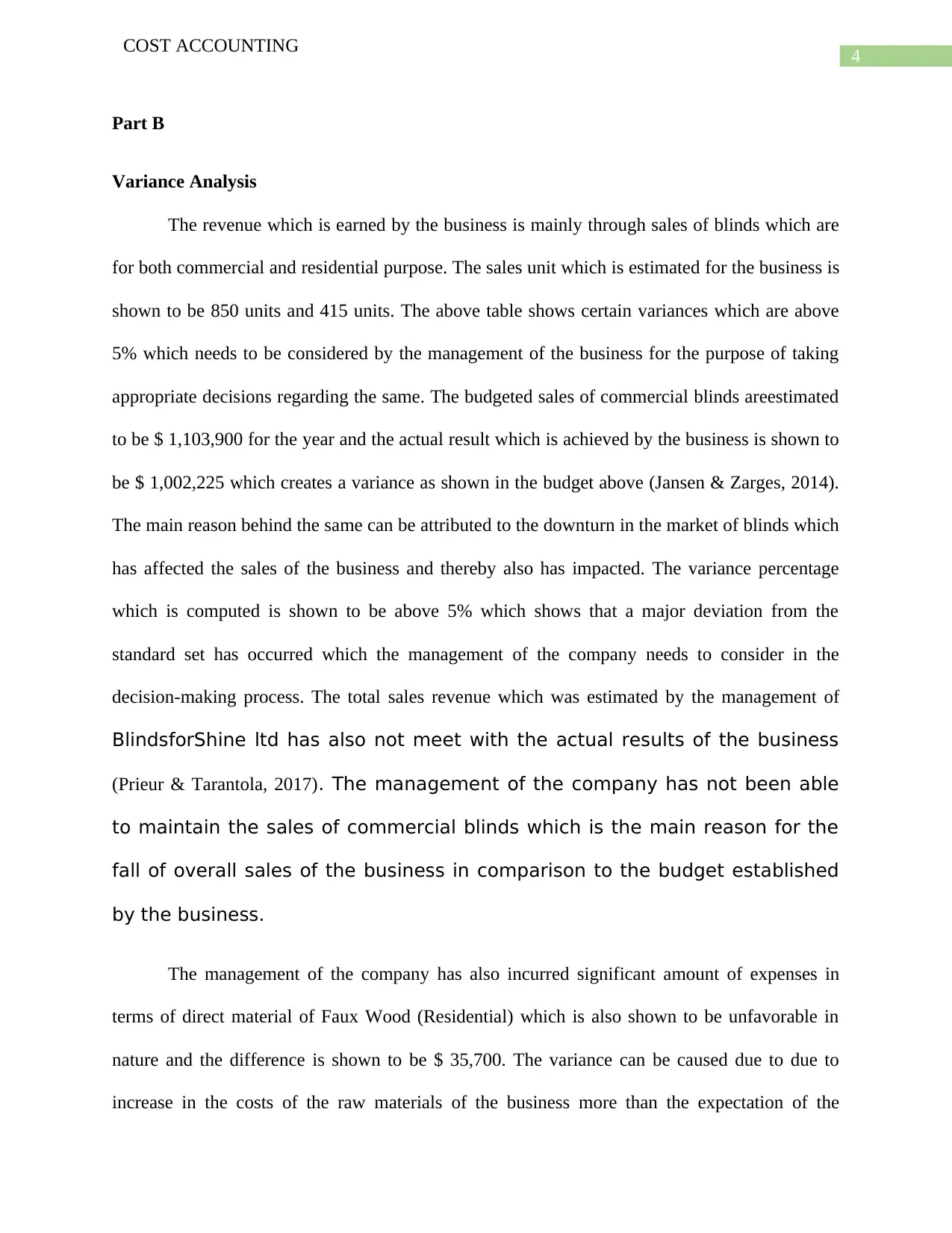
4
COST ACCOUNTING
Part B
Variance Analysis
The revenue which is earned by the business is mainly through sales of blinds which are
for both commercial and residential purpose. The sales unit which is estimated for the business is
shown to be 850 units and 415 units. The above table shows certain variances which are above
5% which needs to be considered by the management of the business for the purpose of taking
appropriate decisions regarding the same. The budgeted sales of commercial blinds areestimated
to be $ 1,103,900 for the year and the actual result which is achieved by the business is shown to
be $ 1,002,225 which creates a variance as shown in the budget above (Jansen & Zarges, 2014).
The main reason behind the same can be attributed to the downturn in the market of blinds which
has affected the sales of the business and thereby also has impacted. The variance percentage
which is computed is shown to be above 5% which shows that a major deviation from the
standard set has occurred which the management of the company needs to consider in the
decision-making process. The total sales revenue which was estimated by the management of
BlindsforShine ltd has also not meet with the actual results of the business
(Prieur & Tarantola, 2017). The management of the company has not been able
to maintain the sales of commercial blinds which is the main reason for the
fall of overall sales of the business in comparison to the budget established
by the business.
The management of the company has also incurred significant amount of expenses in
terms of direct material of Faux Wood (Residential) which is also shown to be unfavorable in
nature and the difference is shown to be $ 35,700. The variance can be caused due to due to
increase in the costs of the raw materials of the business more than the expectation of the
COST ACCOUNTING
Part B
Variance Analysis
The revenue which is earned by the business is mainly through sales of blinds which are
for both commercial and residential purpose. The sales unit which is estimated for the business is
shown to be 850 units and 415 units. The above table shows certain variances which are above
5% which needs to be considered by the management of the business for the purpose of taking
appropriate decisions regarding the same. The budgeted sales of commercial blinds areestimated
to be $ 1,103,900 for the year and the actual result which is achieved by the business is shown to
be $ 1,002,225 which creates a variance as shown in the budget above (Jansen & Zarges, 2014).
The main reason behind the same can be attributed to the downturn in the market of blinds which
has affected the sales of the business and thereby also has impacted. The variance percentage
which is computed is shown to be above 5% which shows that a major deviation from the
standard set has occurred which the management of the company needs to consider in the
decision-making process. The total sales revenue which was estimated by the management of
BlindsforShine ltd has also not meet with the actual results of the business
(Prieur & Tarantola, 2017). The management of the company has not been able
to maintain the sales of commercial blinds which is the main reason for the
fall of overall sales of the business in comparison to the budget established
by the business.
The management of the company has also incurred significant amount of expenses in
terms of direct material of Faux Wood (Residential) which is also shown to be unfavorable in
nature and the difference is shown to be $ 35,700. The variance can be caused due to due to
increase in the costs of the raw materials of the business more than the expectation of the

5
COST ACCOUNTING
management (Sunarni, 2013). The total direct material costs of the business is shown to have
unfavorable balance as the same is more than the budgeted expenses which was estimated by the
management of the company (Chapman, Kern & Laguecir, 2014). The direct labour costs of the
business is shown to be more than the estimation which was made by the business earlier which
is the reason for the variance. The reason for the variance might be the rise in costs of the labor
in the market and also the labour turnover can also be one of the reason for the rise in the costs of
direct labour of the business. The labour turnover rise affects the business as the same requires
business to recruit new employees and also train them to suit the processes of the business. The
variance for direct labour cost is also shown to be more than 5% which is material and therefore
must be considered by the management for the purpose of taking important decisions of the
business. The operating profit of the business is shown to be $ 681,583 as per budgeted estimate
and the actual result of the business is shown to be $ 394,261. The variance is computed to be of
$ 287,293 which shows that the business is not performing as well as the management
anticipates. The lower profit may be caused due to the fall in the sales of the business in
comparison to the budgeted expenses of the business and also the costs of direct material and
direct labour is much more than what was anticipated by the management.
Recommendation for Variances
The variances of the budgets need to be considered by the management of the business
and in accordance to the materiality of the variance appropriate steps are to taken by the
management to rectify the situation as soon as possible. Variances represent lapses in the
performance standard of the business or faulty setting of the budget. Therefore, it is always a
necessity that the budget should be prepared with proper estimation and forecasting. The
variances which appear in the budget between the actual results and the budgeted estimates are
COST ACCOUNTING
management (Sunarni, 2013). The total direct material costs of the business is shown to have
unfavorable balance as the same is more than the budgeted expenses which was estimated by the
management of the company (Chapman, Kern & Laguecir, 2014). The direct labour costs of the
business is shown to be more than the estimation which was made by the business earlier which
is the reason for the variance. The reason for the variance might be the rise in costs of the labor
in the market and also the labour turnover can also be one of the reason for the rise in the costs of
direct labour of the business. The labour turnover rise affects the business as the same requires
business to recruit new employees and also train them to suit the processes of the business. The
variance for direct labour cost is also shown to be more than 5% which is material and therefore
must be considered by the management for the purpose of taking important decisions of the
business. The operating profit of the business is shown to be $ 681,583 as per budgeted estimate
and the actual result of the business is shown to be $ 394,261. The variance is computed to be of
$ 287,293 which shows that the business is not performing as well as the management
anticipates. The lower profit may be caused due to the fall in the sales of the business in
comparison to the budgeted expenses of the business and also the costs of direct material and
direct labour is much more than what was anticipated by the management.
Recommendation for Variances
The variances of the budgets need to be considered by the management of the business
and in accordance to the materiality of the variance appropriate steps are to taken by the
management to rectify the situation as soon as possible. Variances represent lapses in the
performance standard of the business or faulty setting of the budget. Therefore, it is always a
necessity that the budget should be prepared with proper estimation and forecasting. The
variances which appear in the budget between the actual results and the budgeted estimates are
⊘ This is a preview!⊘
Do you want full access?
Subscribe today to unlock all pages.

Trusted by 1+ million students worldwide

6
COST ACCOUNTING
important as the same are useful in maintain supervision and control over the activities of the
business. The corrective measures which can be taken by the management of BlindsforShine
ltd are discussed below in details:
There is a major variance in sales which is achieved by the business which may be due to
the downturn in the market and also due to competition in the market. The management
needs to make innovative changes in the products in order to stay ahead of the
competitors of the business and also incorporate an effective advertisement plan which
will then help the business to promote its products and make the people know about the
attributes of the products which is offered by the company. Effective promotion of the
product will increase the sales of the products and thereby the sales revenue of the
business.
The budget report also shows that the overall costs of materials are more than anticipated
by the business. This problem can be solved with the help of changing the purchase
pattern of raw materials for the business (Mbawuni & Anertey, 2014). The business can
purchase the raw materials in bulk and effectively store the same which will reduce the
material costs of the business and the management will be able to meet the necessary
budgeting estimates.
The direct labour costs of the business is also shown to be more than the estimates which
are considered by the business in the budgeting process. The reason for the variance may
be due to the increase in the labour rates in the market or due to high turnover ratio of
employees in the business (Fullerton, Kennedy & Widener, 2013). The management
needs to formulate a strategy through which the business is able to retain and motivate
the employees of the business. The employees of the business can be motivated by
COST ACCOUNTING
important as the same are useful in maintain supervision and control over the activities of the
business. The corrective measures which can be taken by the management of BlindsforShine
ltd are discussed below in details:
There is a major variance in sales which is achieved by the business which may be due to
the downturn in the market and also due to competition in the market. The management
needs to make innovative changes in the products in order to stay ahead of the
competitors of the business and also incorporate an effective advertisement plan which
will then help the business to promote its products and make the people know about the
attributes of the products which is offered by the company. Effective promotion of the
product will increase the sales of the products and thereby the sales revenue of the
business.
The budget report also shows that the overall costs of materials are more than anticipated
by the business. This problem can be solved with the help of changing the purchase
pattern of raw materials for the business (Mbawuni & Anertey, 2014). The business can
purchase the raw materials in bulk and effectively store the same which will reduce the
material costs of the business and the management will be able to meet the necessary
budgeting estimates.
The direct labour costs of the business is also shown to be more than the estimates which
are considered by the business in the budgeting process. The reason for the variance may
be due to the increase in the labour rates in the market or due to high turnover ratio of
employees in the business (Fullerton, Kennedy & Widener, 2013). The management
needs to formulate a strategy through which the business is able to retain and motivate
the employees of the business. The employees of the business can be motivated by
Paraphrase This Document
Need a fresh take? Get an instant paraphrase of this document with our AI Paraphraser
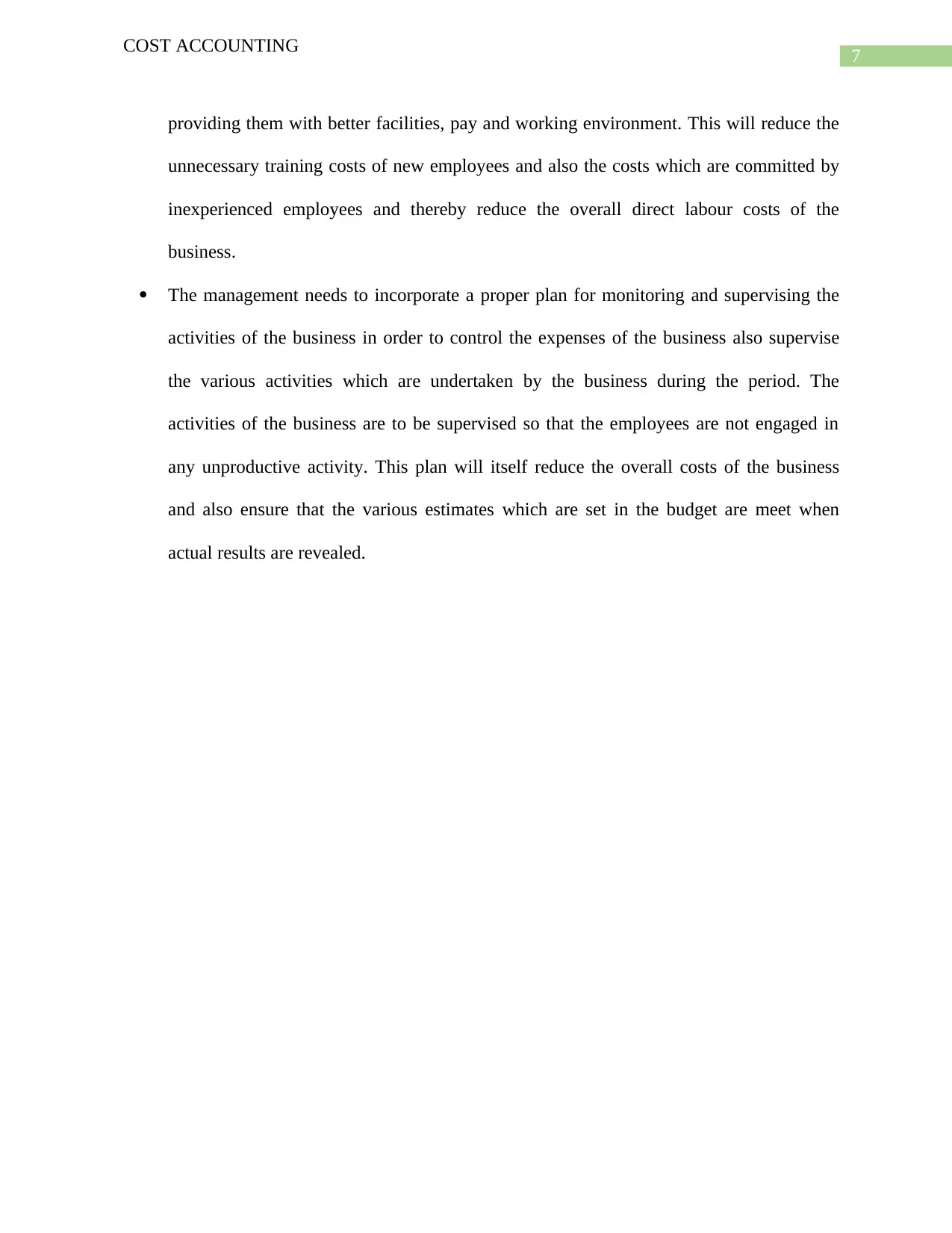
7
COST ACCOUNTING
providing them with better facilities, pay and working environment. This will reduce the
unnecessary training costs of new employees and also the costs which are committed by
inexperienced employees and thereby reduce the overall direct labour costs of the
business.
The management needs to incorporate a proper plan for monitoring and supervising the
activities of the business in order to control the expenses of the business also supervise
the various activities which are undertaken by the business during the period. The
activities of the business are to be supervised so that the employees are not engaged in
any unproductive activity. This plan will itself reduce the overall costs of the business
and also ensure that the various estimates which are set in the budget are meet when
actual results are revealed.
COST ACCOUNTING
providing them with better facilities, pay and working environment. This will reduce the
unnecessary training costs of new employees and also the costs which are committed by
inexperienced employees and thereby reduce the overall direct labour costs of the
business.
The management needs to incorporate a proper plan for monitoring and supervising the
activities of the business in order to control the expenses of the business also supervise
the various activities which are undertaken by the business during the period. The
activities of the business are to be supervised so that the employees are not engaged in
any unproductive activity. This plan will itself reduce the overall costs of the business
and also ensure that the various estimates which are set in the budget are meet when
actual results are revealed.
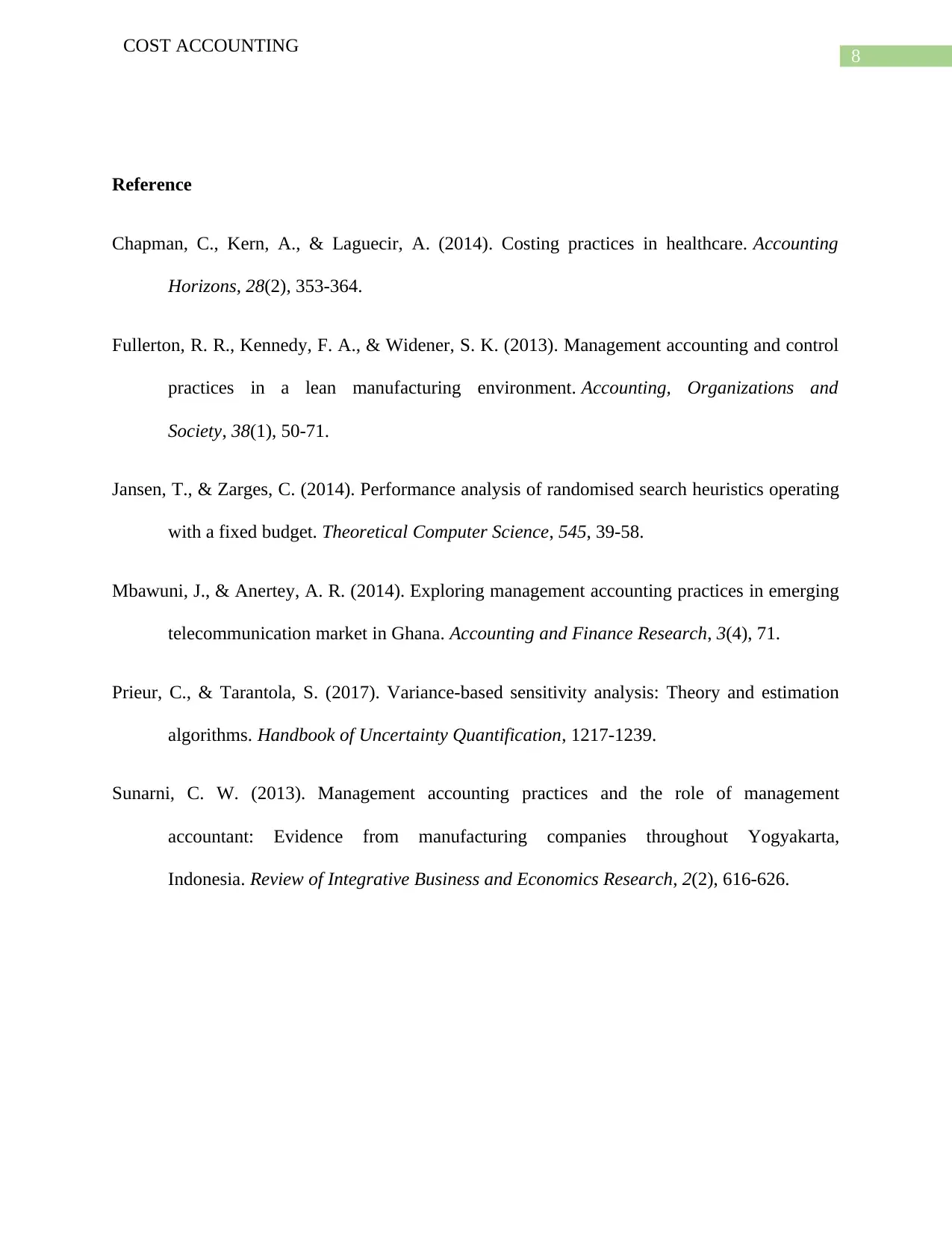
8
COST ACCOUNTING
Reference
Chapman, C., Kern, A., & Laguecir, A. (2014). Costing practices in healthcare. Accounting
Horizons, 28(2), 353-364.
Fullerton, R. R., Kennedy, F. A., & Widener, S. K. (2013). Management accounting and control
practices in a lean manufacturing environment. Accounting, Organizations and
Society, 38(1), 50-71.
Jansen, T., & Zarges, C. (2014). Performance analysis of randomised search heuristics operating
with a fixed budget. Theoretical Computer Science, 545, 39-58.
Mbawuni, J., & Anertey, A. R. (2014). Exploring management accounting practices in emerging
telecommunication market in Ghana. Accounting and Finance Research, 3(4), 71.
Prieur, C., & Tarantola, S. (2017). Variance-based sensitivity analysis: Theory and estimation
algorithms. Handbook of Uncertainty Quantification, 1217-1239.
Sunarni, C. W. (2013). Management accounting practices and the role of management
accountant: Evidence from manufacturing companies throughout Yogyakarta,
Indonesia. Review of Integrative Business and Economics Research, 2(2), 616-626.
COST ACCOUNTING
Reference
Chapman, C., Kern, A., & Laguecir, A. (2014). Costing practices in healthcare. Accounting
Horizons, 28(2), 353-364.
Fullerton, R. R., Kennedy, F. A., & Widener, S. K. (2013). Management accounting and control
practices in a lean manufacturing environment. Accounting, Organizations and
Society, 38(1), 50-71.
Jansen, T., & Zarges, C. (2014). Performance analysis of randomised search heuristics operating
with a fixed budget. Theoretical Computer Science, 545, 39-58.
Mbawuni, J., & Anertey, A. R. (2014). Exploring management accounting practices in emerging
telecommunication market in Ghana. Accounting and Finance Research, 3(4), 71.
Prieur, C., & Tarantola, S. (2017). Variance-based sensitivity analysis: Theory and estimation
algorithms. Handbook of Uncertainty Quantification, 1217-1239.
Sunarni, C. W. (2013). Management accounting practices and the role of management
accountant: Evidence from manufacturing companies throughout Yogyakarta,
Indonesia. Review of Integrative Business and Economics Research, 2(2), 616-626.
⊘ This is a preview!⊘
Do you want full access?
Subscribe today to unlock all pages.

Trusted by 1+ million students worldwide
1 out of 9
Your All-in-One AI-Powered Toolkit for Academic Success.
+13062052269
info@desklib.com
Available 24*7 on WhatsApp / Email
![[object Object]](/_next/static/media/star-bottom.7253800d.svg)
Unlock your academic potential
Copyright © 2020–2025 A2Z Services. All Rights Reserved. Developed and managed by ZUCOL.

